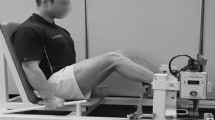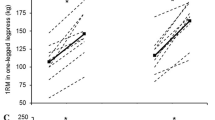Abstract
Purpose
To examine acute responses and recovery of force and serum hormones to combined endurance and strength loadings utilizing different orders of exercises before and after training.
Methods
Physically active men were matched to an order sequence of endurance followed by strength (E + S, n = 12) or strength followed by endurance (S + E, n = 17). The subjects performed one experimental loading consisting of steady-state cycling and a leg press protocol before and after 24 weeks of order-specific combined training.
Results
No between-group difference in acute reductions of force was observed at week 0 (E + S −23 %, p < 0.001; S + E −22 %, p < 0.01) and 24 (E + S −25 %, p < 0.001; S + E −27 %, p < 0.001) and recovery in force was completed after 24 h in both groups at week 0 and 24. Concentrations of growth hormone (22-kDa) increased post-acute loading at week 0 (E + S, +57 fold, p < 0.05; S + E, +300 fold, p < 0.001; between-groups p < 0.001) and 24 (E + S, +80 fold, p < 0.01; S + E, +340 fold, p < 0.05; between-groups p < 0.05). No significant acute responses in concentrations of testosterone were observed at week 0 or 24. However, at week 0 testosterone was reduced during recovery following the E + S loading only (24 h −23 %, p < 0.01; 48 h −21 %, p < 0.001; between-groups at 24 and 48 h, p < 0.05), but was no longer observed after training. 1RM strength improved similarly in E + S (13 %, p < 0.001) and S + E (17 %, p < 0.001).
Conclusions
This study showed an order effect (E + S vs. S + E) in concentrations of testosterone during 2 days of recovery at week 0, which was diminished after 24 weeks of training. The initial difference in testosterone concentrations during recovery did not seem to be associated with strength development.




Similar content being viewed by others
Abbreviations
- C:
-
Cortisol
- CK:
-
Creatine kinase
- E:
-
Endurance
- ECG:
-
Electrocardiogram
- ES:
-
Effect size
- E + S:
-
Endurance followed by strength
- GH:
-
Growth hormone (22-kDa)
- MVCmax :
-
Maximal isometric bilateral leg press force
- S:
-
Strength
- SD:
-
Standard deviation
- S + E:
-
Strength followed by endurance
- T:
-
Testosterone
- TSH:
-
Thyroid stimulating hormone
- \({\dot{\text{V}}\text{O}}_{{ 2 {\text{max}}}}\) :
-
Maximal oxygen consumption
- 1RM:
-
One repetition maximum
References
Ahtiainen JP, Pakarinen A, Kraemer WJ, Häkkinen K (2003a) Acute hormonal and neuromuscular responses and recovery to forced vs. maximum repetitions multiple resistance exercises. Int J Sports Med 24:410–418
Ahtiainen JP, Pakarinen A, Alen M, Kraemer WJ, Häkkinen K (2003b) Muscle hypertrophy, hormonal adaptations and strength development during strength training in strength-trained and untrained men. Eur J Appl Physiol 89:555–563
Aunola S, Rusko H (1986) Aerobic and anaerobic thresholds determined from venous lactate or from ventilation and gas exchange in relation to muscle fiber composition. Int J Sports Med 7:161–166
Cadore EL, Izquierdo M, dos Santos MG et al (2012) Hormonal responses to concurrent strength and endurance training with different exercise orders. J Strength Cond Res 26:3281–3288
Chtara M, Chaouacrn A, Levin GT et al (2008) Effect of concurrent endurance and circuit resistance training sequence on muscular strength and power development. J Strength Cond Res 22:1037–1045
Daly W, Seegers CA, Rubin D, Dobridge JD, Hackney AC (2005) Relationship between stress hormones and testosterone with prolonged endurance exercise. Eur J Appl Physiol 93:375–380
Daussin F, Ponsot E, Dufour S et al (2007) Improvement of VO2max by cardiac output and oxygen extraction adaptation during intermittent versus continuous endurance training. Eur J Appl Physiol 101:377–383
Dill DB, Costill DL (1974) Calculation of percentage changes in volumes of blood, plasma, and red cells in dehydration. J Appl Physiol 37:247–248
Hackney AC, Viru A (2008) Research methodology: endocrinologic measurements in exercise science and sports medicine. J Athl Train 43:631–639
Hackney AC, Kallman A, Hosick KP, Rubin DA, Battaglini CL (2012) Thyroid hormonal responses to intensive interval versus steady-state endurance exercise sessions. Hormones 11:54–60
Häkkinen K, Pakarinen A (1993) Acute hormonal responses to two different fatiguing heavy resistance protocols in males athletes. J Appl Physiol 74:882–887
Häkkinen K, Pakarinen A, Kallinen M (1992) Neuromuscular adaptations and serum hormones in women during short-term intensive strength training. Eur J Appl Physiol Occup Physiol 64:106–111
Häkkinen K, Kallinen M, Izquierdo M et al (1998) Changes in agonist-antagonist EMG, muscle CSA, and force during strength training in middle-aged and older people. J Appl Physiol 84:1341–1349
Häkkinen K, Pakarinen A, Kraemer WJ, Newton RU, Alen M (2000) Basal concentrations and acute responses of serum hormones and strength development during heavy resistance training in middle-aged and elderly men and women. J Gerontol A Biol Sci Med Sci 55:B95–B105
Helgerud J, Hoydal K, Wang E et al (2007) Aerobic high-intensity intervals improve VO2max more than moderate training. Med Sci Sports Exerc 39:665–671
Henneman E, Somjen G, Carpenter DO (1965) Excitability and inhibitability of motoneurons of different sizes. J Neurophysiol 28:599–620
Izquierdo M, Ibanez J, Calbet JA et al (2009) Neuromuscular fatigue after resistance training. Int J Sports Med 30:614–623
Izquierdo M, Gonzalez-Izal M, Navarro-Amezqueta I et al (2011) Effects of strength training on muscle fatigue mapping from surface EMG and blood metabolites. Med Sci Sports Exerc 43:303–311
Kargotich S, Goodman C, Keast D, Morton AR (1998) The influence of exercise-induced plasma volume changes on the interpretation of biochemical parameters used for monitoring exercise, training and sport. Sports Med 26:101–117
Kraemer WJ, Ratamess NA (2004) Fundamentals of resistance training: progression and exercise prescription. Med Sci Sports Exerc 36:674–688
Kraemer WJ, Ratamess NA (2005) Hormonal responses and adaptations to resistance exercise and training. Sports Med 35:339–361
Kraemer WJ, Marchitelli L, Gordon SE et al (1990) Hormonal and growth factor responses to heavy resistance exercise protocols. J Appl Physiol 69:1442–1450
Kraemer WJ, Patton JF, Gordon SE et al (1995) Compatibility of high-intensity strength and endurance training on hormonal and skeletal muscle adaptations. J Appl Physiol 78:976–989
Kuoppasalmi K, Naveri H, Harkonen M, Adlercreutz H (1980) Plasma cortisol, androstenedione, testosterone and luteinizing hormone in running exercise of different intensities. Scand J Clin Lab Invest 40:403–409
Kvorning T, Andersen M, Brixen K, Madsen K (2006) Suppression of endogenous testosterone production attenuates the response to strength training: a randomized, placebo-controlled, and blinded intervention study. Am J Physiol Endocrinol Metab 291:E1325–E1332
Lepers R, Theurel J, Hausswirth C, Bernard T (2008) Neuromuscular fatigue following constant versus variable-intensity endurance cycling in triathletes. J Sci Med Sport 11:381–389
Leveritt M, Abernethy PJ (1999) Acute effects of high-intensity endurance exercise on subsequent resistance activity. J Strength Con Res 13:47–51
Linnamo V, Pakarinen A, Komi PV, Kraemer WJ, Häkkinen K (2005) Acute hormonal responses to submaximal and maximal heavy resistance and explosive exercises in men and women. J Strength Cond Res 19:566–571
McCall GE, Byrnes WC, Fleck SJ, Dickinson A, Kraemer WJ (1999) Acute and chronic hormonal responses to resistance training designed to promote muscle hypertrophy. Can J Appl Physiol 24:96–107
McCaulley GO, McBride JM, Cormie P et al (2009) Acute hormonal and neuromuscular responses to hypertrophy, strength and power type resistance exercise. Eur J Appl Physiol 105:695–704
Moore AW, Timmerman S, Brownlee KK, Rubin DA, Hackney AC (2005) Strenuous, fatiguing exercise: relationship of cortisol to circulating thyroid hormones. Int J Endocri Metbol 1:18–24
Pritzlaff CJ, Wideman L, Weltman JY et al (1999) Impact of acute exercise intensity on pulsatile growth hormone release in men. J Appl Physiol 87:498–504
Schumann M, Eklund D, Taipale RS et al (2013) Acute neuromuscular and endocrine responses and recovery to single-session combined endurance and strength loadings: “order effect” in untrained young men. J Strength Cond Res 27:421–433
Stokes KA, Gilbert KL, Hall GM, Andrews RC, Thompson D (2013) Different responses of selected hormones to three types of exercise in young men. Eur J Appl Physiol 113:775–783
Taipale RS, Häkkinen K (2013) Acute hormonal and force responses to combined strength and endurance loadings in men and women: the “order effect”. PLoS One 8:e55051
Thompson WR, Gordon NF, Pescatello LS (2010) ACSM’s guidelines for exercise testing and prescription, 8th edn. Lippincott Williams & Wilkins, Philadelphia
Vingren JL, Kraemer WJ, Ratamess NA, Anderson JM, Volek JS, Maresh CM (2010) Testosterone physiology in resistance exercise and training: the up-stream regulatory elements. Sports Med 40:1037–1053
Walker S, Ahtiainen JP, Häkkinen K (2010) Acute neuromuscular and hormonal responses during contrast loading: effect of 11 weeks of contrast training. Scand J Med Sci Sports 20:226–234
West DWD, Burd NA, Tang JE et al (2010) Elevations in ostensibly anabolic hormones with resistance exercise enhance neither training-induced muscle hypertrophy nor strength of the elbow flexors. J Appl Physiol 108:60–67
Wilson JM, Marin PJ, Rhea MR, Wilson SMC, Loenneke JP, Anderson JC (2012) Concurrent training: a meta-analysis examining interference of aerobic and resistance exercises. J Strength Cond Res 26:2293–2307
Acknowledgments
The funding for this study has been partially provided by the Finnish Ministry of Education and Culture. The authors would like to express their gratitude to the technical staff involved in the data collection. Furthermore, the subjects who allowed this study to be conducted are highly acknowledged.
Conflict of interest
The authors of this manuscript do not have conflicts of interest.
Author information
Authors and Affiliations
Corresponding author
Additional information
Communicated by Toshio Moritani.
Rights and permissions
About this article
Cite this article
Schumann, M., Walker, S., Izquierdo, M. et al. The order effect of combined endurance and strength loadings on force and hormone responses: effects of prolonged training. Eur J Appl Physiol 114, 867–880 (2014). https://doi.org/10.1007/s00421-013-2813-6
Received:
Accepted:
Published:
Issue Date:
DOI: https://doi.org/10.1007/s00421-013-2813-6




